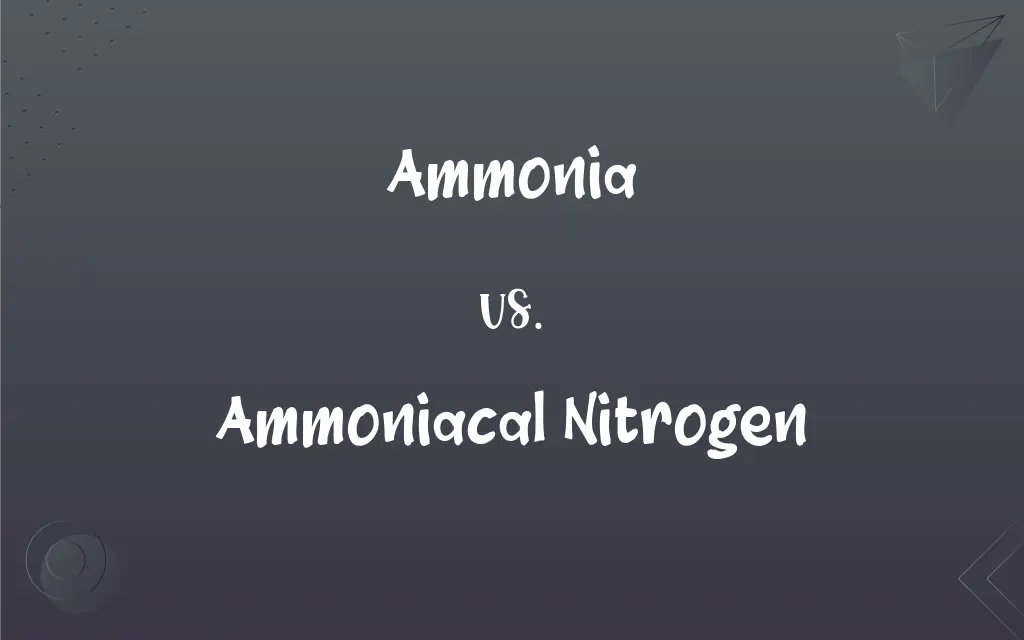Ammonia vs. Ammoniacal Nitrogen: What's the Difference?
Edited by Aimie Carlson || By Janet White || Published on March 3, 2024
Ammonia is a compound of nitrogen and hydrogen (NH3), while ammoniacal nitrogen refers to the total concentration of ammonia and its ionized form (NH4+) in a substance.

Key Differences
Ammonia is a chemical compound composed of nitrogen and hydrogen atoms, with the formula NH3. It is a colorless gas with a characteristic pungent smell. Ammoniacal nitrogen, on the other hand, refers to the sum of the concentrations of ammonia (NH3) and the ammonium ion (NH4+) in a sample. This distinction is important in environmental science and water quality monitoring, as both forms can exist simultaneously in equilibrium, depending on the pH of the solution.
Ammonia, due to its gaseous state under standard conditions, can be released into the atmosphere from agricultural practices or industrial processes. In contrast, ammoniacal nitrogen is a term often used in the context of aqueous solutions, such as wastewater or natural water bodies, indicating the presence of both ammonia gas dissolved in water and its ionized form, ammonium.
The measurement of ammoniacal nitrogen is crucial for assessing the nitrogen content in water and soil, which can be an indicator of pollution levels. Ammonia itself is toxic to aquatic life in high concentrations, and its transformation into ammonium can further affect water chemistry and biology. Therefore, understanding the balance between ammonia and ammoniacal nitrogen is essential for environmental protection and management.
In environmental regulations and water treatment processes, controlling the levels of ammonia and ammoniacal nitrogen is a priority. Ammonia can be converted to ammonium in water, and vice versa, depending on the water's pH and temperature. This dynamic interplay affects the toxicity and treatment strategies of nitrogenous compounds in water.
Both ammonia and ammoniacal nitrogen serve as key nutrients for plant growth. However, their availability and uptake by plants depend on the soil's pH and moisture content. While ammonia can be directly used by some plants, ammonium is more commonly assimilated, making the understanding of their roles crucial for agricultural practices.
ADVERTISEMENT
Comparison Chart
Chemical Form
NH3 (a compound of nitrogen and hydrogen)
NH3 + NH4+ (total concentration of ammonia and ammonium)
State of Matter
Gas (or dissolved gas in water)
Aqueous solution component
Environmental Relevance
Toxic to aquatic life in high concentrations; used in industrial processes
Indicator of water pollution; includes both NH3 and NH4+ forms
Measurement Context
Often measured as a gas or in atmospheric studies
Measured in water or soil to assess nitrogen levels
Role in Agriculture
Directly usable by some plants; used as a fertilizer
Important for understanding plant-available nitrogen in soil
ADVERTISEMENT
Ammonia and Ammoniacal Nitrogen Definitions
Ammonia
Ammonia acts as a refrigerant in cooling systems, exploiting its high vaporization heat.
Large-scale refrigeration systems often use ammonia due to its efficiency.
Ammoniacal Nitrogen
Ammoniacal nitrogen's balance influences the effectiveness of wastewater treatment processes.
Adjusting the ammoniacal nitrogen levels is essential for achieving clean effluent.
Ammonia
Ammonia is a colorless gas with a sharp, pungent odor used in various industrial processes.
Ammonia is commonly used in the manufacture of fertilizers.
Ammoniacal Nitrogen
Ammoniacal nitrogen is a key parameter in assessing water quality and aquatic ecosystem health.
High levels of ammoniacal nitrogen can indicate contamination in a river.
Ammonia
Ammonia is a precursor to many nitrogen-containing compounds in both industry and biological systems.
Synthesizing nitric acid often begins with ammonia.
Ammoniacal Nitrogen
Ammoniacal nitrogen is involved in the nitrogen cycle, playing a role in the conversion of nitrogen forms.
Understanding ammoniacal nitrogen dynamics is crucial for environmental science.
Ammonia
A colorless, pungent gas, NH3, extensively used to manufacture fertilizers and a wide variety of nitrogen-containing organic and inorganic chemicals. Ammonia is the chief nitrogen product excreted by fish and other aquatic animals.
Ammoniacal Nitrogen
Ammoniacal nitrogen content is critical for agricultural soil management, affecting crop yield.
Soil tests for ammoniacal nitrogen help farmers optimize fertilizer use.
Ammonia
See ammonium hydroxide.
Ammoniacal Nitrogen
Ammoniacal nitrogen measures the total nitrogen available as ammonia and ammonium in water.
Wastewater treatment plants monitor ammoniacal nitrogen to prevent pollution.
Ammonia
(inorganic compound) A gaseous compound of hydrogen and nitrogen, NH3, with a pungent smell and taste.
Ammonia
A solution of this compound in water used domestically as a cleaning fluid.
Never use ammonia to clean metal writing pens.
Ammonia
A gaseous compound of hydrogen and nitrogen, NH3, with a pungent smell and taste: - often called volatile alkali, and spirits of hartshorn.
Ammonia
A pungent gas compounded of nitrogen and hydrogen (NH3)
Ammonia
A water solution of ammonia
Ammonia
Ammonia serves as a cleaning agent, known for its effectiveness in removing tough grime.
Household cleaners often contain ammonia for its grease-cutting properties.
Ammonia
Ammonia participates in nitrogen fixation, an essential process for plant nutrition.
Certain bacteria convert atmospheric nitrogen into ammonia, feeding plants.
FAQs
Why is ammoniacal nitrogen important in water treatment?
It indicates the level of nitrogen pollution, guiding treatment processes to remove nitrogen compounds.
Can ammonia exist in water?
Yes, ammonia can dissolve in water, and it can also react with water to form ammonium ions.
What is ammonia?
Ammonia is a compound of nitrogen and hydrogen with the formula NH3, known for its pungent smell.
What does ammoniacal nitrogen represent?
It represents the total amount of ammonia (NH3) and ammonium ion (NH4+) present in a substance.
How is ammonia used in agriculture?
As a direct source of nitrogen for crops, ammonia is a key component of many fertilizers.
What is the difference between ammonia and ammonium?
Ammonia is a gas at room temperature, while ammonium is its ionized form in aqueous solutions.
What effect does ammonia have on aquatic life?
It can be toxic to fish and other aquatic organisms at high concentrations.
Why monitor ammoniacal nitrogen in agriculture?
To ensure soils have adequate nitrogen levels for optimal crop growth without causing environmental harm.
Can ammonia be used as a cleaner?
Yes, it's effective in removing grease and grime due to its alkaline properties.
How does ammoniacal nitrogen affect water pH?
It can influence the acidity or alkalinity of water, affecting the solubility and toxicity of other compounds.
What role does ammoniacal nitrogen play in the environment?
It is crucial for understanding nitrogen levels in water bodies, affecting aquatic life and water quality.
Is ammonia harmful to humans?
In high concentrations, ammonia gas can be harmful, causing respiratory issues and eye irritation.
How is ammoniacal nitrogen measured?
Through chemical analysis of water or soil samples, assessing the concentration of ammonia and ammonium.
How do plants use ammoniacal nitrogen?
Plants can absorb nitrogen in the form of ammonium ions, essential for their growth and development.
Is ammonia present in the atmosphere?
Yes, it can be released through agricultural activities and industrial processes.
What is the significance of ammoniacal nitrogen in wastewater?
It helps in evaluating the efficiency of nitrogen removal processes in treatment facilities.
How does temperature affect ammonia in water?
Temperature can influence the equilibrium between ammonia and ammonium, affecting its form and toxicity.
Can ammoniacal nitrogen be a pollution indicator?
Yes, elevated levels can signal contamination from agricultural runoff or sewage leaks.
What safety precautions are necessary when handling ammonia?
Proper ventilation, protective clothing, and eye protection are crucial due to its corrosive nature.
How does ammonia contribute to the nitrogen cycle?
It is a fundamental part of the cycle, acting as a source of nitrogen for many biological processes.
About Author
Written by
Janet WhiteJanet White has been an esteemed writer and blogger for Difference Wiki. Holding a Master's degree in Science and Medical Journalism from the prestigious Boston University, she has consistently demonstrated her expertise and passion for her field. When she's not immersed in her work, Janet relishes her time exercising, delving into a good book, and cherishing moments with friends and family.
Edited by
Aimie CarlsonAimie Carlson, holding a master's degree in English literature, is a fervent English language enthusiast. She lends her writing talents to Difference Wiki, a prominent website that specializes in comparisons, offering readers insightful analyses that both captivate and inform.







































































